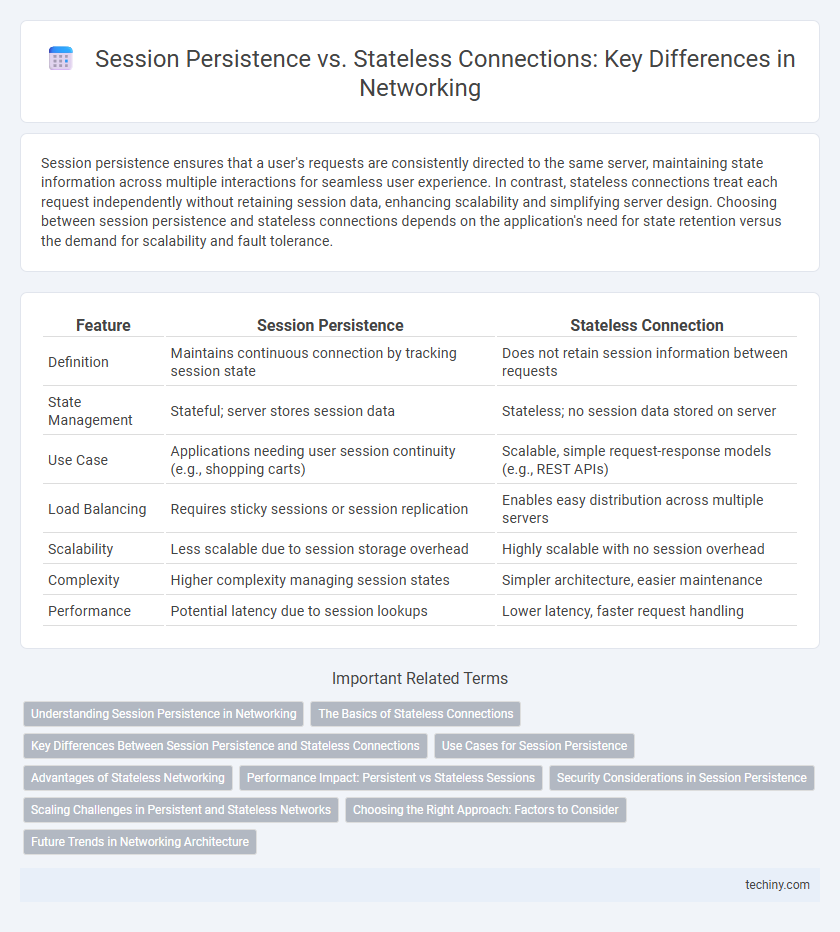Session persistence ensures that a user's requests are consistently directed to the same server, maintaining state information across multiple interactions for seamless user experience. In contrast, stateless connections treat each request independently without retaining session data, enhancing scalability and simplifying server design. Choosing between session persistence and stateless connections depends on the application's need for state retention versus the demand for scalability and fault tolerance.
Table of Comparison
| Feature | Session Persistence | Stateless Connection |
|---|---|---|
| Definition | Maintains continuous connection by tracking session state | Does not retain session information between requests |
| State Management | Stateful; server stores session data | Stateless; no session data stored on server |
| Use Case | Applications needing user session continuity (e.g., shopping carts) | Scalable, simple request-response models (e.g., REST APIs) |
| Load Balancing | Requires sticky sessions or session replication | Enables easy distribution across multiple servers |
| Scalability | Less scalable due to session storage overhead | Highly scalable with no session overhead |
| Complexity | Higher complexity managing session states | Simpler architecture, easier maintenance |
| Performance | Potential latency due to session lookups | Lower latency, faster request handling |
Understanding Session Persistence in Networking
Session persistence in networking ensures a user's requests are consistently directed to the same server during a session, maintaining stateful communication and enhancing user experience. This technique helps manage load balancing by tracking session data, preventing disruptions caused by switching servers mid-session. Understanding session persistence is crucial for designing scalable and reliable networks that support applications requiring continuous data exchange, such as online banking or e-commerce platforms.
The Basics of Stateless Connections
Stateless connections in networking do not retain any session information between requests, enabling each interaction to be processed independently and efficiently. This approach reduces server memory usage and simplifies scalability by treating every request as a new transaction without relying on previous interactions. Common protocols that utilize stateless connections include HTTP, where the absence of session persistence allows for faster and more flexible data exchanges.
Key Differences Between Session Persistence and Stateless Connections
Session persistence maintains a continuous connection by storing user state information across multiple requests, enabling consistent and personalized network interactions. Stateless connections, in contrast, treat each request independently without retaining user data, leading to simpler and more scalable network designs. The key difference lies in session persistence's reliance on state management for seamless user experiences, while stateless connections prioritize efficiency and reduced server overhead by avoiding state retention.
Use Cases for Session Persistence
Session persistence is crucial in e-commerce platforms where maintaining user state during multiple transactions ensures a seamless shopping experience. It is also essential in online banking applications, enabling continuous authentication and personalized service without disruptions. Load balancers use session persistence to route user requests consistently to the same server, optimizing performance and resource management.
Advantages of Stateless Networking
Stateless networking enhances scalability by allowing servers to handle each request independently without storing session information, reducing resource consumption. It simplifies load balancing and fault tolerance, as any server can respond to requests without requiring session data synchronization. This model improves reliability and reduces complexity, making it ideal for cloud-based and distributed systems.
Performance Impact: Persistent vs Stateless Sessions
Session persistence improves performance by maintaining a continuous connection between client and server, reducing the overhead of repeated authentication and state synchronization. Stateless connections, while more scalable and fault-tolerant, introduce latency due to re-establishing session information with each request. Persistent sessions optimize resource usage in load-balanced environments by minimizing server-side computations for each interaction.
Security Considerations in Session Persistence
Session persistence enhances security by maintaining consistent user sessions, reducing the risk of session hijacking through continuous server association. Implementing secure cookies, IP binding, and encrypted session tokens strengthens protection against unauthorized access. Stateless connections lack inherent session tracking, requiring additional measures like token-based authentication to mitigate security vulnerabilities.
Scaling Challenges in Persistent and Stateless Networks
Session persistence in networks ensures continuous user connections by maintaining state information, which can lead to scaling challenges due to increased memory and processing requirements on load balancers. Stateless connections, by treating each request independently without storing session data, offer better scalability and simpler resource management but may complicate user experience continuity. Balancing the need for efficient scaling with seamless session management requires strategic load balancing and session data distribution in persistent networks.
Choosing the Right Approach: Factors to Consider
When choosing between session persistence and stateless connections, evaluate the application's need for maintaining user state versus scalability demands. Session persistence ensures consistent user experience by retaining session data, critical for applications like online banking or shopping carts. Stateless connections offer better load balancing and fault tolerance, ideal for high-traffic environments where quick, independent requests improve system performance.
Future Trends in Networking Architecture
Future networking architectures increasingly favor stateless connections to enhance scalability and fault tolerance in cloud-native environments and microservices. Session persistence remains essential for legacy systems requiring consistent user sessions, but emerging technologies like edge computing and AI-driven load balancing are shifting toward dynamic, ephemeral connections. Advances in protocols such as HTTP/3 and QUIC support faster, more reliable stateless communications, aligning with the move toward decentralized, software-defined network infrastructures.
Session Persistence vs Stateless Connection Infographic

 techiny.com
techiny.com